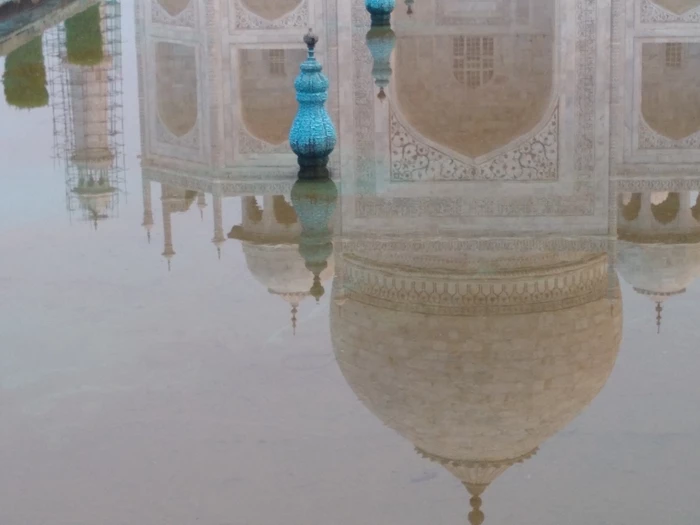
Wednesday, September 25, 2019
Copper (II) sulfate is the product of the reaction between copper metal and sulfuric acid. It's water soluble and moderately toxic.
Copper (II) oxide is the result of the breakdown of Copper (I) oxide in humid air. It's not particularly toxic, but regular exposure can cause copper to accumulate in the body, eventually leading to neurological, liver, and kidney problems.
According to the 2018 New York City Drinking Water Supply Quality Report, the average concentration of copper is 0.008 milligrams per liter of water, taken across 464 samples. However, the majority of copper contamination in New York City comes from copper pipes in buildings, while the water report samples at the mains. Separate, smaller samples (481 of them) are taken "at the tap." The finding is that concentrations of copper in drinking water can be as high as 0.483 milligrams per liter of water, though ninety percent of samples are below 0.185 milligrams per liter.
Anyway, here are some pictures of the Taj Mahal:
You get the idea. White, pretty, enormous. Totally my type. We even saw some monkeys:
I said, "oh, more monkeys!" Our guide for that day replied, slightly amused, "Yes, more monkeys. Don't go near them."
The Taj Mahal is in the city of Agra, which is not Delhi. So, Mr. Singh drove us for a few hours through the Indian countryside. You can probably guess from his name that Mr. Singh has a beard and wears a turban, which makes him easy to identify though a windshield. He could be a tour guide himself (as Andrea noted), not just a driver, for all he told us along the way.
Indians are really into cows. It makes me feel bad about eating them (cows, not Indians). As we entered the open country, I began to notice tiny thatched huts spotting the farmlands. They seemed much too small to be homes, but maybe they were sheds. Mr. Singh explained that this is where cow manure is stored until it dries into a hard cake, which can then be used as fuel. Gas fires are unnatural, while this fuel is manifestly natural, and so it is preferable. I don't know whether it smells like manure when it burns, but it probably doesn't smell like hickory.
Once this was pointed out to me, I was floored by number of these huts. Later, when we were driving through a town, we could see large cylinders of the stuff rolled up on the side of the road, in its marketable form.
It's not just the poop, either. Cows are everywhere in Agra. If a cow wants to lie down in the road, it lies down in the road. If a cow wants to pick through garbage, it picks through garbage. If a cow is crossing the road and decides that actually it wants to go back the other way, it does so. They don't moove in response to car horns as reliably as dogs do, so our driver mostly just steered around them.
Small herds of cows are led each day on the side of the road from the farms into town, where they're milked early in the morning, then loiter around blocking traffic and sniffing the ground, and then return to the farms to graze until they are milked again in the evening.
Women squat in the fields collecting the dung, and a man is often nearby "helping" (Mr. Singh says that the piles can get heavy, and so maybe the man is there just in case he is needed, should the woman call in an upper body strength strike).
You want to see some pictures of cows? Well, I'm as surprised as you are that I don't have any. In India so far I have taken more pictures of pigeons, the undisputed rulers of New York City, than I have of Hindu's sacred animal. I'll try to correct this before returning to Delhi.
We saw more than the Taj Mahal in Agra. The first tour was of the so-called "mini Taj," properly the tomb of I'timād-ud-Daulah. You can read about the history on wikipedia. The thing to note in the pictures is how the white marble is integrated with the red sandstone. I can no longer think of the terms "white marble" and "red sandstone" without an Indian accent.
The Mughals were trying out the whole "white marble" thing in the tomb of I'timād-ud-Daulah. It ended up looking so badass that, when the Taj Mahal was built, they went balls deep with the marble. The marble was barged over from Jaipur on a river.
Here's the "mini Taj."
There are two styles of ornamentation at play. One is inlaid stonework (pietra dura), and the other is mural painting. In a similar way to how the Taj Mahal shed the red stone preferring marble, the Taj Mahal also is relatively devoid of murals, instead using extensive pietra dura.
But that's all pretty boring, isn't it? Check out these camels.
As we approached this caravan from afar, Mr. Singh said "look, elephants!" After a few seconds I contributed, "they're very small elephants," and I don't remember if it was Andrea or Mr. Singh who first admitted that they're camels. The lesson here is that you should never mistake a camel for an elephant. Thank you for listening.
My favorite picture so far is this one:
Rashād watches over all of us from his kingly roost. HDR is really growing on me.
Speaking of elephants, here is what they look like:
Yes, we exploited the elephants. I'm sorry, ok? To be honest, had we known that the item on the tour mentioning elephants was a touristastic ride up a hill, we would have left it out; but, the tour is a package, and who knew what the elephant part was about?
Also, what have you done to protect the well-being of elephants? You're a hypocrite, and you know it, and that's why you're going to hell when you die.
If you're not sure what I'm talking about, then read this kind of stuff until you're crying.
For what it's worth, Mr. Singh and our guide claimed that the use of elephants for tourism in India is regulated by the government, that each elephant is limited in the amount of work it is allowed to be made to do in a day, and that everything is really just fantastic. On the other hand, Mr. Singh also said that car crashes are relatively rare in India due to the low speed of travel, but in actuality vehicular deaths are four times more likely in India than they are in the Americas.
I'm just saying that I wish well for the elephants. Moving on.
Ok, one more thing about the elephants. Two things. The first is that Andrea had the sensibility to greet the elephant once we dismounted it, and earlier asked the mahout what the elephant's name is, how old she is, and how old the mahout is. The pair of them were twenty and twenty-five years old (I don't remember who was older), and the elephant was named something that sounded like "Sonya." I looked at the elephant's face when Andrea bent down to meet her, and I couldn't read her expression. Andrea said something similar afterward. Do I sound guilty? I feel guilty. In fairness, elephants did not evolve facial cues to be understood by untrained humans.
The second thing is the picture above. When you're swaying back and forth on the saddle strapped to a moving elephant, photographers try their best to get a decent shot of you, and then presumably later pressure you to pay them for the photographs. We suffered no such trouble, but once we got to the top, I was amused to get the "behind the scenes" shot.
Here is a picture of doorframes framing door frames.
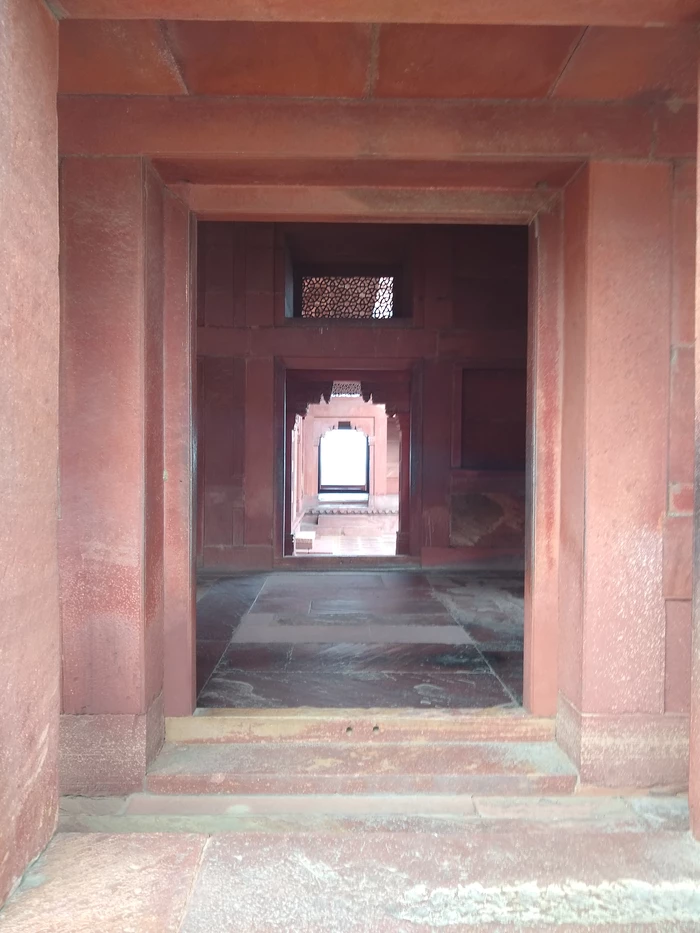
Here is a picture of someone taking a picture of doorframes framing doorframes.
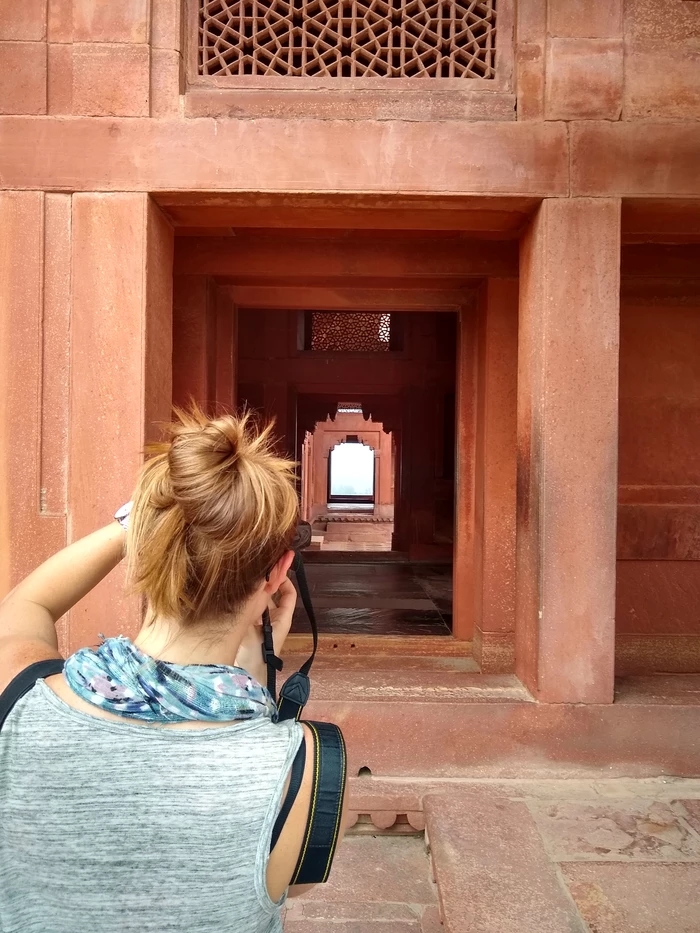
We need to go deeper.
Here is a picture of a blog post being prepared about a picture of someone
taking a picture of doorframes framing doorframes.

Here is a picture of Asha the cat.
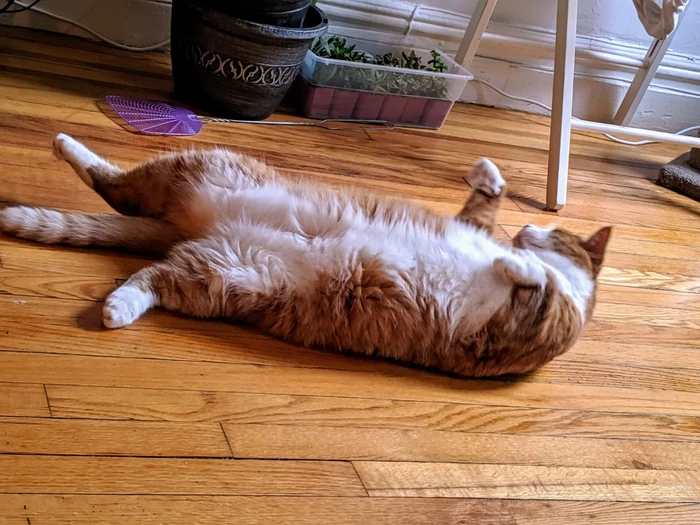
We saw a bunch of palaces. The Mughals moved here, and then they moved there, and then they moved back again, and then a prince killed his brothers and imprisoned his father and somebody built the Taj Mahal. I'm probably getting some of this wrong. People died, it was all deadly serious. Also, harems.
The first palace was inside of a fort. If you look closely, there are cows.
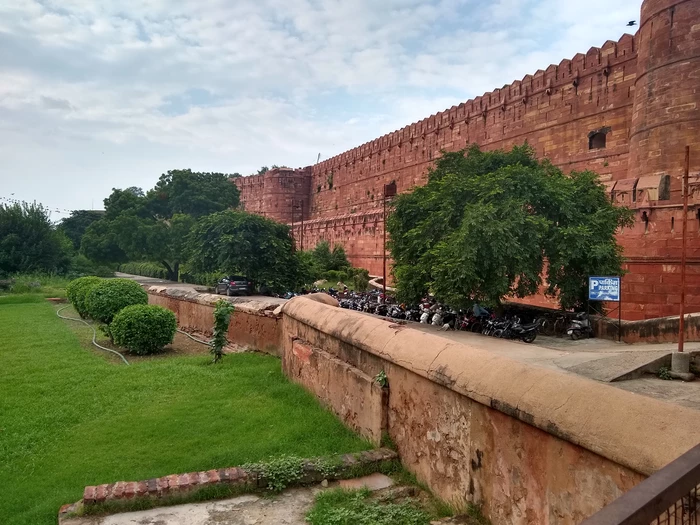
Inside of the fort, there are multiple layers of defensive obstacles. There
are attack monkeys,
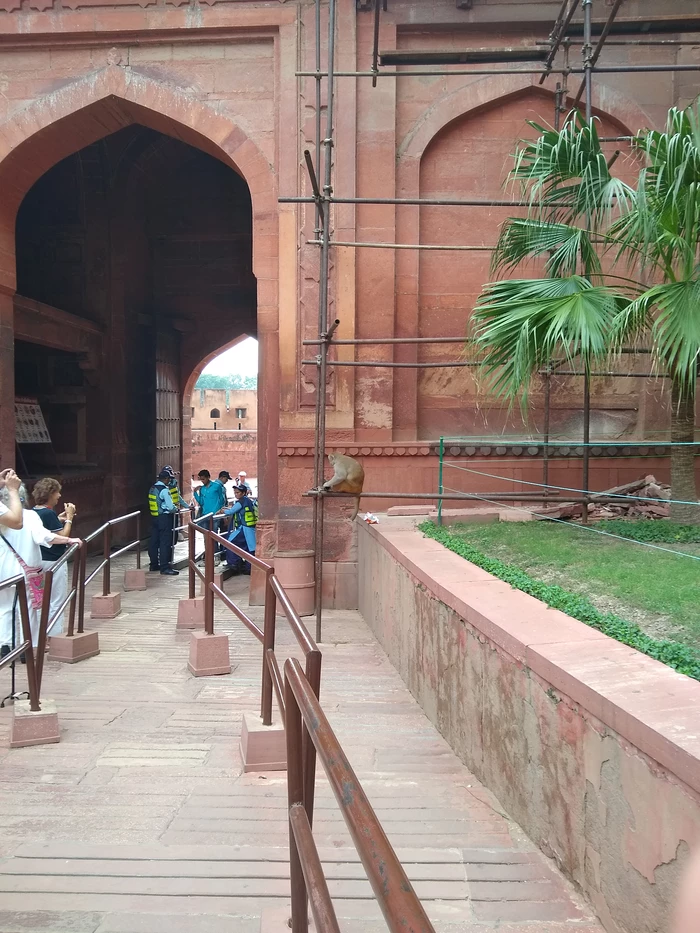
and arresting views of the vast, lush landscape that would pull invaders into
a state of placid reflection, whence they can be slain by arrows or boiling
oil.
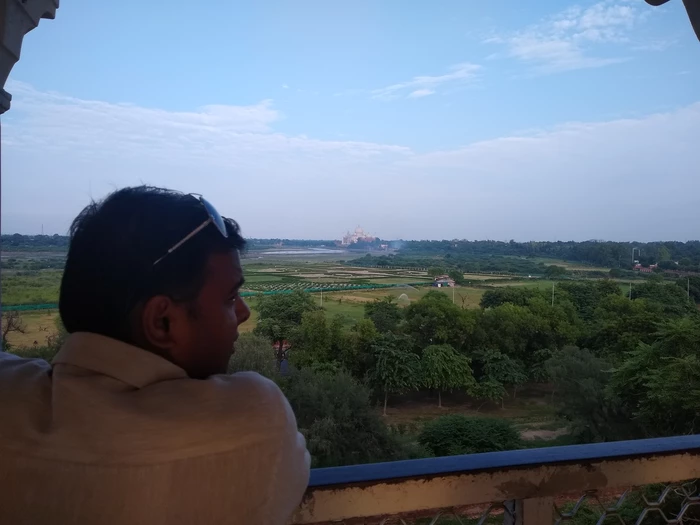
The guy in the picture was our tour guide in Agra. He was alright. I found him off-putting in a subtle way. There was a rote thinness to his presentation, and he more often deflected questions than answered them. Andrea suggested that he was acting like a salesman who isn't selling anything. I thought that he was crushed by the monotony of saying the same things in the same way in the same places nearly every day for years and years. Sometimes, after an energetic monologue, he would turn away and sigh.
The fort palace has three notable sections. The first is the courtyard where the king would address a private audience. It's real fancy.
The second section is the king's private quarters, which is even fancier.
The last section is the courtyard where the king would address a public audience. I'm not sure what is meant by "public."
One of the kings married three wives: a Muslim, a Christian, and a Hindu. The Muslim wife lived in a lavishly decorated shoebox. The Christian wife lived in a small flat (I found dubious the tour guide's claim that the hallway's entrance into three rooms signified the crucifix).
The Hindu wife lived in a palace of her own within the palace. She is also the wife that bore the king fourteen children, so they were definitely doing it. The other token wives did not bear the king any children.
Here are some pictures of the palace in which the king, his three wives, and a ton of other people temporarily lived while away from the fort.
These tours do this thing that's new to me. Mr. Singh motivated it for us on the way from Delhi to Agra. You go to a showroom adjacent to a factory where some good is made, such as marble pietra dura, textiles, or jewelry. In the showroom there is a small sample of workers making the good. A salesman shows you how the good is made, offers a sometimes-interactive demonstration of the process, and then takes you to a proper showroom where you receive a full length infomercial about everything you can buy there, and then if you like you can buy things, all the while attended to by a very dedicated salesman.
I was reminded of the scene in Indiana Jones and the Last Crusade where the Nazis try to bribe the local ruler with a chest of gold and silver treasures, coins, jewelry, and gems (perhaps all stolen from wealthy Jews), but the ruler is much more interested in the car that the Nazis drove there.
I couldn't get myself to buy anything on any of those occasions, but Andrea did pick up some marble, and as a result, the salesmen gifted me a rough-hewn marble elephant (methinks from the reject pile). So, I have a souvenir for myself, anyway.
Ah, I think I left the elephant at the hotel room in Agra. So it was with me but for a short time.
Mr. Singh recommended a buffet style restaurant for dinner, and drove us there. Andrea and I assumed that he would be joining us for dinner, but he did not. Maybe we should have invited him to stay. The "appetizers" presented to us constituted at least a two course meal, after which we were supposed to go up to the buffet and get more food, and that's not to mention dessert. I lightened up after a beer and a half, fortunately.
The next day began early with a cloudy sunrise tour of the Taj Mahal, which I've already shown you. Later we bid our mediocre tour guide farewell and hit the road again with Mr. Singh, this time for Jaipur.
In Jaipur I was reminded that I have a condition known as resting bitch face. On a long high school marching band trip bus ride, one of my closest friends at the time scrutinized me in silence during a pause in the conversation and felt the need to ask, "are you ok, dude?" I turned to him and said, "yeah, I'm fine." He said, "because you look pissed." I thought about it and told him, "I'm just tired." He looked at me slightly incredulously and said, mostly to himself, "so you look angry when you're tired."
In fact, it's not only when I'm tired. It's any time I make no effort to convey emotion using my facial muscles. Also I hate everybody.
The friendly and slightly avian jewelry salesman told me point blank, "smile, won't you?" I smiled and told him that we were tired.
For example, behold this impromptu pout:
The elephants were leading us up to a palace on a hill, my favorite palace of the trip:
Our tour guide in Jaipur was much better than the previous. It was a state secret how that silver shone for so many years without tarnishing. Such secrets were kept by a family of artisans. A metalworker would not even tell his own daughters the secrets, since then when she was married she could spill the beans to another family. He would tell his daughters in law, though, since they were more part of his family, at least politically.
The secret is that it's not silver, it's a tin amalgam. Surprise! Andrea wondered whether working with the mercury caused health problems, and so I told her about the mad hatters.
There were many things to look at.
Does the following building look to you like it's partially submerged?
There's an 18th Century observatory in Jaipur, where giant instruments are made of stone. For example, this building is a sundial. It is a sundial.
The triangular steppy thing casts a shadow on the curved marble thing, and on the latter are marked two-second increments. On a morning with good direct sunlight, you could watch the shadow crawl across the ticks in real time.
Here is an image of the dome of the night sky, carved in stone:
There are two versions, each omitting half of the sky to make room for astonomers and/or astrologers to stand and take measurements. Simple solution, no?
A similar thing happens here. A tall poll to the right casts the shadow of its tip on one of the little rectangles. As the sun moves across the sky, you can plot the curve of its transit, and from this deduce the current inclination of the Earth in the plane of the solar system, and probably a bunch of other things.
Next we went to a museum on the grounds of the current royal family of Jaipur, but we wouldn't take pictures inside. Nearby, there was this:
I forget what it is, but it looks cool.
We were thoroughly pooped when we returned to the hotel late that afternoon. They also moved us into a room with two proper beds, so Andrea could end her stay on the cot from the previous night.
Today is a down day. We might do something this afternoon, and we might not.
There is a nice pool. Tonight is a cooking class.
